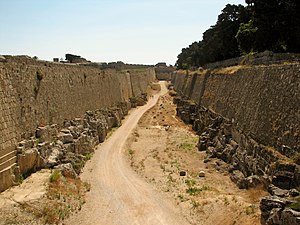Siege of Rhodes (1522)
| Siege of Rhodes | |||||||
|---|---|---|---|---|---|---|---|
| Part of the Ottoman wars in Europe | |||||||
 The English Post, the scene of heaviest fighting; the tenaille is on the left and the main wall is further behind it, visible in the background; on the right of the wide dry ditch is the counterscarp that the attackers had to climb down before storming the city wall. The ditch is enfiladed by the Tower of St. John, its bulwark and lower wall providing vertically stacked fields of overlapping fire. The stone cannon balls seen in the ditch are from the fighting. |
|||||||
|
|||||||
| Belligerents | |||||||
|
|
|
||||||
| Commanders and leaders | |||||||
|
Suleiman the Magnificent Çoban Mustafa Pasha Kurtoğlu Muslihiddin Reis |
Philippe Villiers de L'Isle-Adam | ||||||
| Strength | |||||||
| 200,000 men 400 ships |
7,500 men
|
||||||
| Casualties and losses | |||||||
| 20,000 men? | 6,000+ men | ||||||
Ottoman victory
7,500 men
The Siege of Rhodes of 1522 was the second and ultimately successful attempt by the Ottoman Empire to expel the Knights of Rhodes from their island stronghold and thereby secure Ottoman control of the Eastern Mediterranean. The first siege in 1480 had been unsuccessful.
The Knights of St. John, or Knights Hospitallers, had captured Rhodes in the early 14th century after the loss of Acre, the last Crusader stronghold in Palestine in 1291. From Rhodes, they became an active part of the trade in the Aegean sea, and at times harassed Turkish shipping in the Levant to secure control over the eastern Mediterranean. A first effort by the Ottomans to capture the island, in 1480, was repulsed by the Order, but the continuing presence of the knights just off the southern coast of Anatolia was a major obstacle to Ottoman expansion.
Since the previous siege the fortress had received many upgrades from the new school of trace italienne, which made it much more formidable in resisting artillery. In the most exposed land-facing sectors, these included a thickening of the main wall, doubling of the width of the dry ditch, coupled with a transformation of the old counterscarp into massive outworks (tenailles), the construction of bulwarks around most towers, and caponiers enfilading the ditch. Gates were reduced in number, and the old battlement parapets were replaced with slanting ones suitable for artillery fights. A team of masons, labourers and slaves did the construction work, the Muslim slaves were charged with the hardest labor.
In 1521, Philippe Villiers de L'Isle-Adam was elected Grand Master of the Order. Expecting a new Ottoman attack on Rhodes, he continued to strengthen the city's fortifications, work that had begun after the Ottoman invasion of 1480 and the earthquake of 1481, and called upon the Order's knights elsewhere in Europe to come to the island's defence. The rest of Europe ignored his request for assistance, but some Venetian troops from Crete joined the knights, and Sir John Rawson, Prior of the Order's Irish House, came alone. The city was protected by two and, in some places three, rings of stone walls and several large bastions. The defence of the walls and bastions was assigned in sections to the different Langues into which the knights had been organized since 1301. The harbour entrance was blocked by a heavy iron chain, behind which the Order's fleet was anchored.
...
Wikipedia
